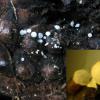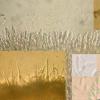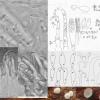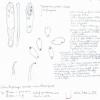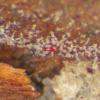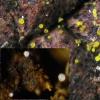
20-01-2026 17:49
 Hardware Tony
Hardware Tony
I offer this collection as a possibility only as e

15-01-2026 15:55
 Lothar Krieglsteiner
Lothar Krieglsteiner
this one is especially interesting for me because

17-01-2026 19:35
Arnold BüschlenHallo, ich suche zu Cosmospora aurantiicola Lite

16-01-2026 00:45
Ethan CrensonHi all, On decorticated hardwood from a New York

18-01-2026 12:24
Hello.An anamorph located on the surface of a thin

08-12-2025 17:37
 Lothar Krieglsteiner
Lothar Krieglsteiner
20.6.25, on branch of Abies infected and thickened
Hamatocanthoscypha/Psilocistella
Javier Ormad,
03-01-2011 00:43
The case is that following the key Raitvir leads me to H. ocellata.
To see what you think about:
Apothecia white (is kept in after time) slightly stalked up to 1 mm in diameter
Buen año. Os presento este especimen hallado sobre cono caido joven de P. halepensis. Podría encajar con Psilocistella conincola (Hamatocanthoscypha conincola, no se si sería válido) aunque Raitvir piensa que es una forma extrema de H. laricionis??
El caso es que siguiendo la clave de Raitvir, me lleva a H. ocellata.
A ver que os parece a vosotros:
Apotecios blancos (se mantinen tras tiempo) ligeramente estipitados de hasta 1 mm de diámetro
Javier Ormad,
03-01-2011 00:45
Re:Hamatocanthoscypha/Psilocistella
De gran dificultad
Asci cylindrical clavate, biseriate, 8 spores, apical pore blue croziers of 38-45 x 3.5-4.5 microns. Fusoid elliptical asymmetric ascospores smooth, hyaline. with 2 guttae in spore ends, 5-8 x 2-2.5 microns. Paraphyses filiform, uniforms, and some branched straight. Hairs with shapes, some straight and some with ripple-shaped apical rod, thin-walled, hyaline, with basal septum, showing vacuolar inclusions and other surface smooth and finely some rough or small scale, up to 40 x 2 microns in size . Ectal Excípulo prismatic structure with presence of hyaline cells randomly
Asci cylindrical clavate, biseriate, 8 spores, apical pore blue croziers of 38-45 x 3.5-4.5 microns. Fusoid elliptical asymmetric ascospores smooth, hyaline. with 2 guttae in spore ends, 5-8 x 2-2.5 microns. Paraphyses filiform, uniforms, and some branched straight. Hairs with shapes, some straight and some with ripple-shaped apical rod, thin-walled, hyaline, with basal septum, showing vacuolar inclusions and other surface smooth and finely some rough or small scale, up to 40 x 2 microns in size . Ectal Excípulo prismatic structure with presence of hyaline cells randomly
Hans-Otto Baral,
03-01-2011 15:00

Re:Hamatocanthoscypha/Psilocistella
Hi Javier
if your apothecia atr white I would identify hamatocanthoscypha laricionis. This may grow together with yellow H. uncipila, at least I think the two are different species. Some hairs may almost be straight but are typically strongly uncinate.
Zotto
if your apothecia atr white I would identify hamatocanthoscypha laricionis. This may grow together with yellow H. uncipila, at least I think the two are different species. Some hairs may almost be straight but are typically strongly uncinate.
Zotto
Javier Ormad,
04-01-2011 11:50
Re:Hamatocanthoscypha/Psilocistella
According Raitvir key:
9. Spores with prominent polar guttules.... H. ocellata
9'. Spores without inclusions.....................H. laricionis.
The specimen submitted has guttules in spore ends.
What is the difference between the 3 species conincola, laricionis and ocellata? and especially among laricionis and conincola ....
9. Spores with prominent polar guttules.... H. ocellata
9'. Spores without inclusions.....................H. laricionis.
The specimen submitted has guttules in spore ends.
What is the difference between the 3 species conincola, laricionis and ocellata? and especially among laricionis and conincola ....
Hans-Otto Baral,
04-01-2011 16:10

Re:Hamatocanthoscypha/Psilocistella
I do actually not see clear with this species concept. Stip once identifid H. ocellata, but I do not see the differences. In earlier times, especially when not using oil immersion, I also noted eguttulate spores, but later, I mostly saw some small guttules.
Here I give some collections (left by Martin, right below by Piotr). I think this is all laricionis.
Intetresting is that the paraphyses were sometimes guttulate (?VBs) but usually not.
Zotto
Here I give some collections (left by Martin, right below by Piotr). I think this is all laricionis.
Intetresting is that the paraphyses were sometimes guttulate (?VBs) but usually not.
Zotto
Javier Ormad,
04-01-2011 21:28
Re:Hamatocanthoscypha/Psilocistella
I think that fits specimen contributed by Martin and Piotr, another thing is how to call it?
Thank you very much for the information and views presented.
I will continue to provide specimens for your opinions
Thank you very much for the information and views presented.
I will continue to provide specimens for your opinions
Martin Bemmann,
04-01-2011 22:26
Javier Ormad,
04-01-2011 23:40
Martin Bemmann,
04-01-2011 23:42

Re:Hamatocanthoscypha/Psilocistella
Thank you Javier,
I do not know why you can't see my picture. For me it is posted to the forum and visible..
Best regards,
Martin
I do not know why you can't see my picture. For me it is posted to the forum and visible..
Best regards,
Martin
Javier Ormad,
04-01-2011 23:57
Re:Hamatocanthoscypha/Psilocistella
The picture I see, but can not see clearly either the "manitas"(manos pequeñas en español). It is a structure familiar to me that I could relate to a Myxomycetes?
Javier
Javier
Martin Bemmann,
05-01-2011 00:05

Re:Hamatocanthoscypha/Psilocistella
Dear Javier,
thank you for your reply! So I missunderstood you. Do you really think it's a myxo? I missed the chance to look at those structures microsopically..
Regards
Martin
thank you for your reply! So I missunderstood you. Do you really think it's a myxo? I missed the chance to look at those structures microsopically..
Regards
Martin
Javier Ormad,
05-01-2011 00:49
Re:Hamatocanthoscypha/Psilocistella
It's like a Ceratomyxa fruticulosa, but ungrouped (but do not think it is). I hope to remember this if I see it.
Greetings
Greetings


